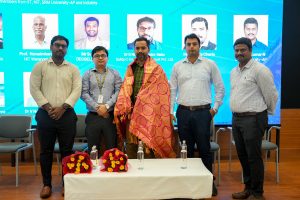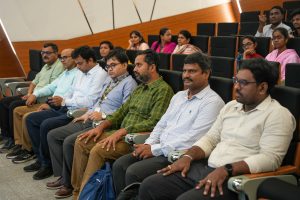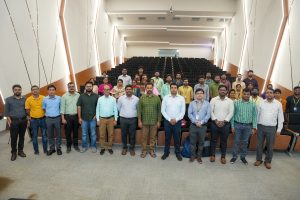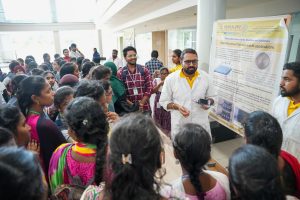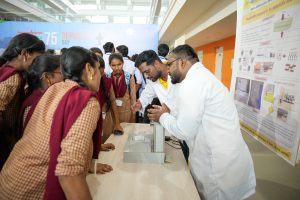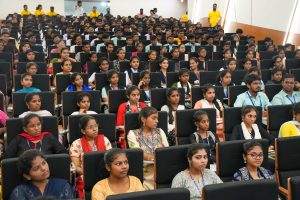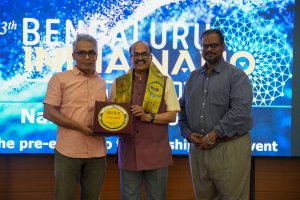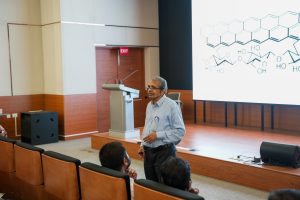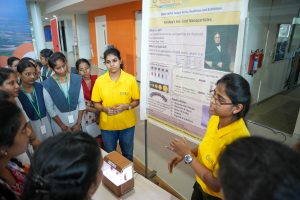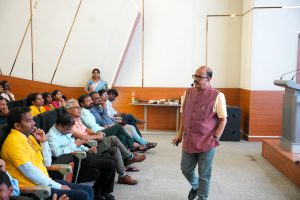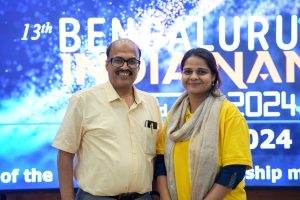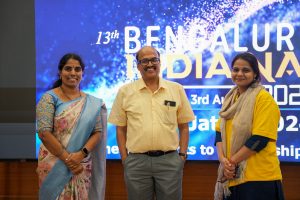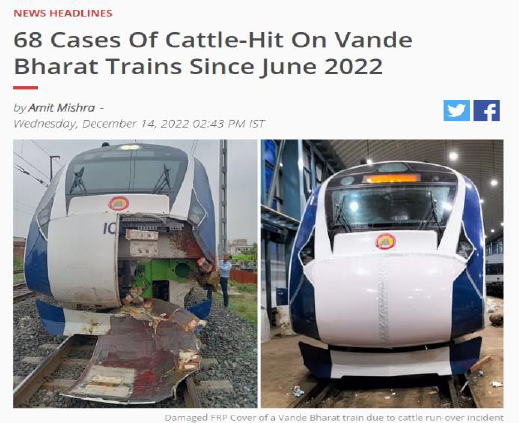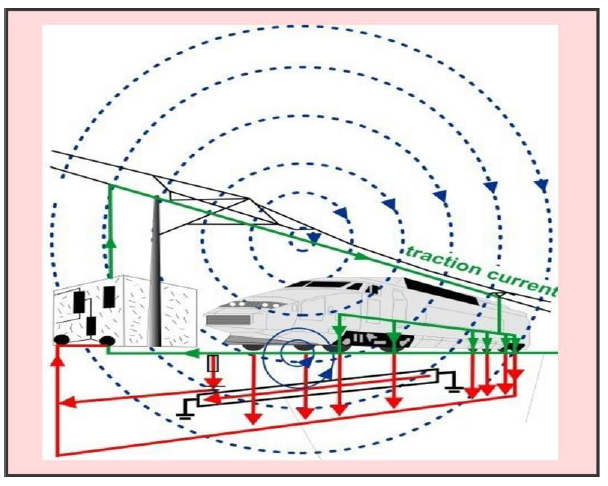Skill Enhancement Programme: Understanding Renewable Energy and Smart Transportation
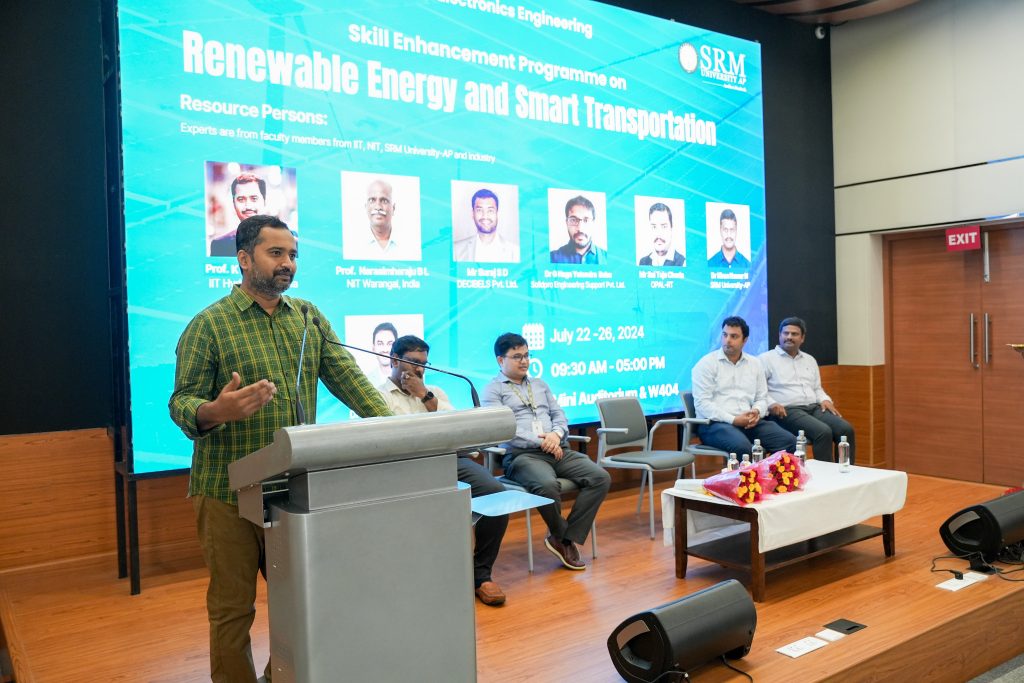
The Department of Electrical and Electronics Engineering hosted a highly successful five-day Skill Enhancement Programme on “Renewable Energy and Smart Transportation” from July 22 to July 26, 2024, signalling a major leap forward in addressing the vital sectors of electric vehicles and renewable energy systems. The programme conducted in a hybrid mode, featured live lectures, hands-on training, and interactive sessions, drawing a total of 50 participants. Chief Guest Dr K Sivakumar, HOD-EEE, IIT Hyderabad, highlighted the pressing need for such skill development initiatives and stressed the importance of keeping abreast of advancements in renewable energy and smart transportation.
Expert sessions on the emerging domains of Renewable Energy, including Advanced Power Conversion and Efficient Drives, Design and Simulation Tools, Battery Management and Charging Infrastructure, and Sustainability and Renewable Integration, fostered an in-depth understanding and application of the latest technologies in these fields.
Dr K Sivakumar started off the programme with an engaging session on advanced power conversion techniques and control strategies for electric vehicles. His insights into modern electric vehicle design set a strong foundation for the week. Participants gained a deep understanding and a solid theoretical base on the latest advancements in power converters and control techniques, which are crucial for the design and development of efficient electric vehicles.
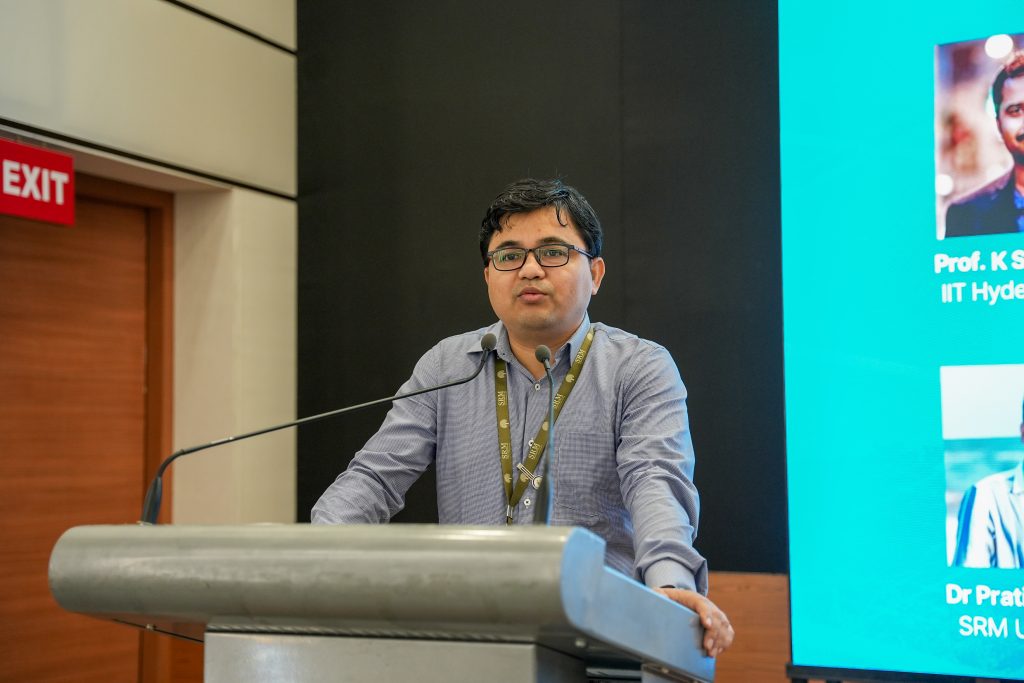
Subsequent technical sessions were led by esteemed experts from academia and industry, such as Dr Narasimharaju B L from NIT Warangal, Mr Suraj from Decibels Pvt. Ltd., Dr G Naga Yatendra Babu from Solidpro Engineering Support Pvt. Ltd., Mr Sai Teja Cherla from OPAL-RT, and Dr Kiran Kumar N, Dr Pratikanta Mishra from and Dr V Naresh Kumar from SRM University-AP.
Overall, the Skill Enhancement Programme provided participants with a comprehensive understanding of renewable energy and smart transportation, blending theoretical knowledge with practical skills and fostering discussions on current challenges and future opportunities in these fields.
- Published in Departmental Events, Departmental News, EEE, EEE NEWS, News
Dr Raviteja K Publishes Book on Sustainable Materials in Civil Infrastructure
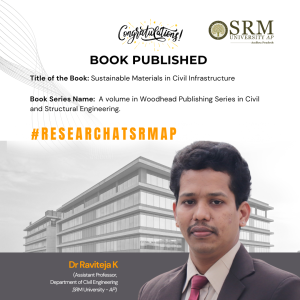 Dr Raviteja K, Assistant Professor in the Department of Civil Engineering, has recently authored a groundbreaking book entitled “Sustainable Materials in Civil Infrastructure.” This publication is set to become a valuable resource for professionals and students in the field, shedding light on the importance of sustainable practices in construction and infrastructure development. His expertise and dedication to promoting environmentally friendly solutions within the realm of civil engineering have culminated in this significant literary contribution. The book delves into the utilization of eco-conscious materials, innovative construction techniques, and the crucial role they play in creating a more sustainable future for infrastructure projects worldwide.
Dr Raviteja K, Assistant Professor in the Department of Civil Engineering, has recently authored a groundbreaking book entitled “Sustainable Materials in Civil Infrastructure.” This publication is set to become a valuable resource for professionals and students in the field, shedding light on the importance of sustainable practices in construction and infrastructure development. His expertise and dedication to promoting environmentally friendly solutions within the realm of civil engineering have culminated in this significant literary contribution. The book delves into the utilization of eco-conscious materials, innovative construction techniques, and the crucial role they play in creating a more sustainable future for infrastructure projects worldwide.
His work is anticipated to inspire a new wave of sustainable practices in the industry and drive positive change towards greener and more resilient civil infrastructure development. Congratulations to Dr. Raviteja K on this remarkable achievement that is sure to make a lasting impact in the field of civil engineering!
Publication details (incl. Publisher, ISBN, Launch date, Edition, etc):
Title: Sustainable Materials in Civil Infrastructure, Publisher: Elseveir, ISBN: 978-0-443-16142-1, Date: July 2024, doi: https://doi.org/10.1016/C2022-0-02477-6.
Brief Introduction the Book:
Sustainable Materials in Civil Infrastructure delves into cutting-edge advancements in eco-materials, offering solutions crucial for building resilient and sustainable infrastructure. It provides profound insights into pioneering research on eco-materials for construction, offering a comprehensive guide on recycled steel, low-carbon concrete, bioconcrete, self-healing concrete, and industrial by-products like fly ash and shape memory alloys. Chapters explore design applications of bioconcrete and the utilisation of eco-materials in landfill liners and masonry, while also addressing obstacles hindering the widespread adoption of green concrete and bioconcrete, proposing practical solutions. This book serves as a cornerstone for the development of sustainable design methodologies, embraced by environmental monitoring bodies worldwide.
Significance of Book
The book “Sustainable Materials in Civil Infrastructure” published by Elsevier is a pivotal resource in the field of sustainable engineering, particularly relevant to my work in developing solutions for geotechnical and geoenvironmental challenges at Sustainable Engineering Research Laboratory (SERL), SRM University AP.
The inclusion of topics such as bioconcrete and the utilization of eco-materials in landfill liners and masonry is particularly significant. Bioconcrete, for instance, exemplifies a pioneering approach by integrating biological processes into construction materials, thereby promoting sustainability and durability. Addressing obstacles to the widespread adoption of green concrete and bioconcrete is also crucial, as it underscores the practical challenges that need to be overcome for these materials to achieve mainstream acceptance.
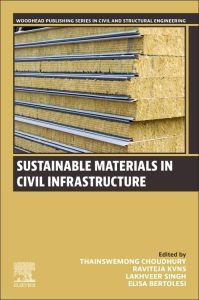
For my research focus at SERL, this book serves as a cornerstone. It not only provides in-depth insights into the latest research and development in sustainable materials but also offers practical guidance on their design applications and integration into infrastructure projects. Moreover, the emphasis on sustainable design methodologies aligns perfectly with our laboratory’s mission to promote environmentally conscious practices in civil engineering.
Target Audience of the Book
The target audience of the book “Sustainable Materials in Civil Infrastructure” includes a wide range of professionals and researchers involved in civil engineering, sustainability, and materials science. Specifically, the book would be helpful and resourceful for:
Civil Engineers, Researchers and Academics, Environmental Engineers, Policy Makers and Regulatory Bodies, Students, Construction Industry Professionals, and Consultants.
Co-authors
The co-editors include: Thainswemong Choudhury, Lakhveer Singh and Elisa Bertolesi
- Published in CIVIL NEWS, Departmental News, News, Research News
Innovation Alert: Patent on Plant Disease Detection Published by CSE Team
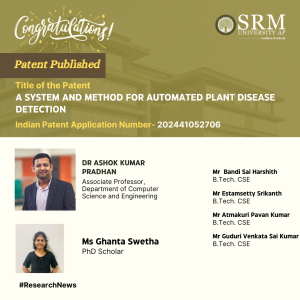 In an impressive achievement, Dr Ashok Kumar Pradhan, Associate Professor of the Department of Computer Science and Engineering, along with PhD Scholar Ms Ghanta Swetha and BTech CSE students Mr Bandi Sai Harshith, Mr Estamsetty Srikanth, Mr Guduri Venkata Sai Kumar, and Mr Atmakuri Pavan Kumar, has successfully published a patent titled “A SYSTEM AND METHOD FOR AUTOMATED PLANT DISEASE DETECTION.” The application has been officially recognised with Application Number: 202441052706, as recorded in the Patent Office Journal.
In an impressive achievement, Dr Ashok Kumar Pradhan, Associate Professor of the Department of Computer Science and Engineering, along with PhD Scholar Ms Ghanta Swetha and BTech CSE students Mr Bandi Sai Harshith, Mr Estamsetty Srikanth, Mr Guduri Venkata Sai Kumar, and Mr Atmakuri Pavan Kumar, has successfully published a patent titled “A SYSTEM AND METHOD FOR AUTOMATED PLANT DISEASE DETECTION.” The application has been officially recognised with Application Number: 202441052706, as recorded in the Patent Office Journal.
This innovative system aims to revolutionise the agricultural sector by providing an automated mechanism for detecting diseases in plants. Thus, it enhances crop management and ensures healthier yields. The team’s dedication to advancing technology and improving agricultural practices showcases the potential of computer science in solving real-world problems.
The patent not only reflects the hard work and collaboration among the faculty and students but also signifies a step forward in the integration of technology with agriculture. As the world faces challenges related to food security, such innovations play a critical role in safeguarding plant health and agricultural productivity.
Congratulations to Dr Pradhan, Ms Swetha, and the student inventors on this significant milestone in their academic and professional endeavours!
Abstract of the Research:
The innovation that is being presented in this project is a software-based system that is intended to help farmers by offering an automated way to identify plant diseases. This innovation combines a number of technological elements:
Convolutional Neural Networks (CNNs): These networks are used to recognise and categorise plant diseases from images of both healthy and sick plants with high accuracy. This is leveraging transfer learning with pre-trained CNN architectures to improve performance even with sparsely annotated data.
MobileNetV2 Architecture: Designed with the specific purpose of classifying agricultural diseases in mind, this model is effective and lightweight, making it ideal for use in resource- constrained settings such as farms.
Weather API Integration: This helps farmers make decisions about crop management and disease prevention by giving them access to real-time weather data.
AI-Powered Website: Acts as a user interface for farmers to communicate with the system, submit plant photos, post queries, and get weather and diagnostic updates.
Chatbot: Utilizes Recurrent Neural Networks (RNN) and Natural Language Processing (NLP) to respond to user inquiries and provide guidance on crop management and disease prevention.
All things considered, this innovation is a system that integrates various software components, artificial intelligence, and data integration to produce a complete tool for raising agricultural productivity and managing diseases.
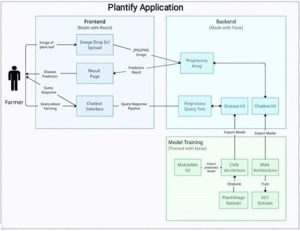
Research in Layperson’s Terms
1. Automated Plant Disease Prediction: Current approaches frequently use traditional diagnostic procedures and manual inspection, which can be laborious and prone to human mistakes. The suggested method uses CNNs to automatically and precisely recognise images, increasing the efficacy and precision of plant disease diagnosis.
2. This project assists farmers in making decisions on crop management and disease prevention by providing them with access to current weather information.
3. Farmers can query various farming issues and receive responses. This is done by leveraging RNNs and NLP.
4. Use of Transfer Learning: The system uses transfer learning to use pre-trained CNN architectures, which enables it to function well even with a small amount of annotated data. Compared to typical machine learning models, which frequently need big datasets and intensive training, this is a major improvement.
Integration with Smart Agriculture Systems: – This method combines disease prediction with smart agriculture systems, allowing for real-time monitoring and decision-making, in contrast to independent diagnostic instruments.
Practical Implementation or the Social Implications Associated
1. Field Diagnosis by Farmers: – Farmers can snap photos of their crops in the fields and instantly receive a disease diagnosis and treatment suggestions by using the platform.
2. Agricultural Extension Services: Using the system, agricultural extension agents may help farmers more effectively by offering guidance and support.
3. Agricultural Research: – Researchers can investigate plant diseases and create novel remedies and management techniques by utilizing the extensive annotated picture library and diagnostic tools.
4. Commercial Farming Operations: – By incorporating the system into their precision agriculture techniques, large-scale farming operations can maximize crop health management and operational effectiveness.
5. Policy Formation and Governance: – Governmental organizations can monitor plant disease outbreaks and create regional or national plans for disease control and prevention using aggregated data from the platform.
Future research plans
We may use privacy and security enhancement tools and techniques to make the data more secure
- Published in CSE NEWS, Departmental News, News, Research News
Dr Dwivedy and Dr Nagasai Upgrade CMT Technology
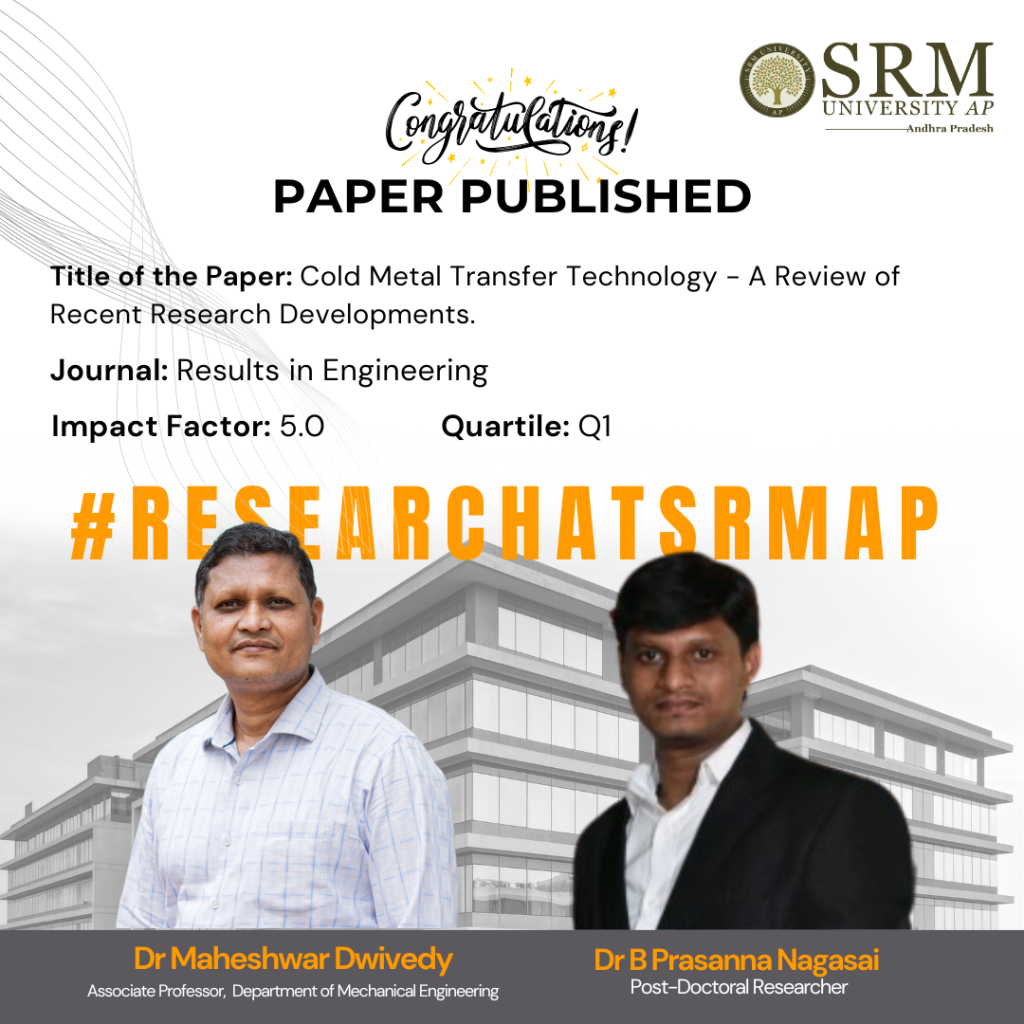
Dr Maheshwar Dwivedy, Associate Dean of Practice School, and Associate Professor, at the Department of Mechanical Engineering, SRM University-AP in collaboration with his post-doctoral scholar, Dr B Prasanna Nagasai, have joined forces to combine artificial intelligence with Cold Metal Transfer (CMT) Technology. Their research paper, “Cold Metal Transfer Technology – A Review of Recent Research Developments,” featured in the Q1 journal, Results in Engineering promises to make a significant impact on automobile, aerospace, oil and gas manufacturing industries, and that’s not all the research will also generate employment opportunities, and empower engineers to deliver enhanced services.
Abstract:
Cold Metal Transfer (CMT) technology has emerged as a promising welding technique, offering numerous advantages such as reduced heat input, minimal spatter, and enhanced control over the welding process. This paper provides a comprehensive review of recent research developments in CMT technology, focusing on its history, variants, recent advancements, and future perspectives. Initially, the paper traces the historical development of CMT welding, highlighting its evolution and the introduction of various CMT variants with distinct characteristics and applications. Recent studies have focused on optimising CMT process parameters to improve weld quality and productivity, leading to advancements in parameter control, arc stability, and wire-feeding mechanisms. Additionally, research has explored the microstructural evolution and mechanical properties of CMT-welded joints for both similar and dissimilar metals, providing insights into material compatibility, joint design, and performance under various conditions. Specific applications such as Laser-CMT hybrid welding, CMT cladding, CMT wire arc additive manufacturing, and CMT welding for repair across various materials are examined, demonstrating the versatility of CMT technology. This review also addresses the challenges and methodologies for defect reduction in CMT welding, along with recommendations for best practices. Furthermore, the paper discusses the integration of artificial intelligence in CMT welding, exploring opportunities for enhanced weld quality, economic, and social implications, and future research directions.
Practical and Social Implications:
The practical implementation of this research on Cold Metal Transfer (CMT) technology can significantly impact various industries, such as automotive, aerospace, oil and gas, and manufacturing. By optimising CMT welding parameters and integrating advanced features like arc length control and waveform modulation, industries can achieve higher weld quality, reduce defects, and enhance productivity. This can lead to more reliable and efficient manufacturing processes, resulting in cost savings and improved product performance. Social implications associated with this research include the potential for increased job opportunities and skill development in the welding and manufacturing sectors. As industries adopt advanced CMT technology, there will be a growing demand for skilled workers trained in these techniques. Additionally, improved welding quality and reduced defects can lead to safer and more durable products, enhancing overall public safety and satisfaction. The integration of artificial intelligence in CMT welding also opens up new avenues for innovation and technological advancements, fostering a culture of continuous improvement and progress in the manufacturing industry.
Collaborations:
Dr V Balasubramanian,
Professor & Director,
Centre for Materials Joining & Research (CEMAJOR)
Annamalai University, Annamalai Nagar-608002, Tamilnadu.
Dr P Snehalatha,
Associate Professor & Head
Department of Mechanical Engineering,
Sri Padmavathi Mahila Visvavidyalam, Tirupati, Andhra Pradesh-517502, India.
Future Research Plans:
The upcoming work will concentrate on creating Functionally Graded Materials (FGMs) through Wire-Arc Additive Manufacturing (WAAM) by merging nickel and stainless steel. The goal of this research is to leverage the distinct properties of each metal to develop components suited for specialised high-performance applications. The primary challenges involve optimizing the interfaces between materials, refining the deposition processes, and ensuring strong structural integrity throughout the manufacturing process.
The link to the article: https://doi.org/10.1016/j.rineng.2024.102423
- Published in Departmental News, Mechanical Engineering NEWS, News, Research News
“Nano Jatha”: A Pathway to Nanoscience and Technology
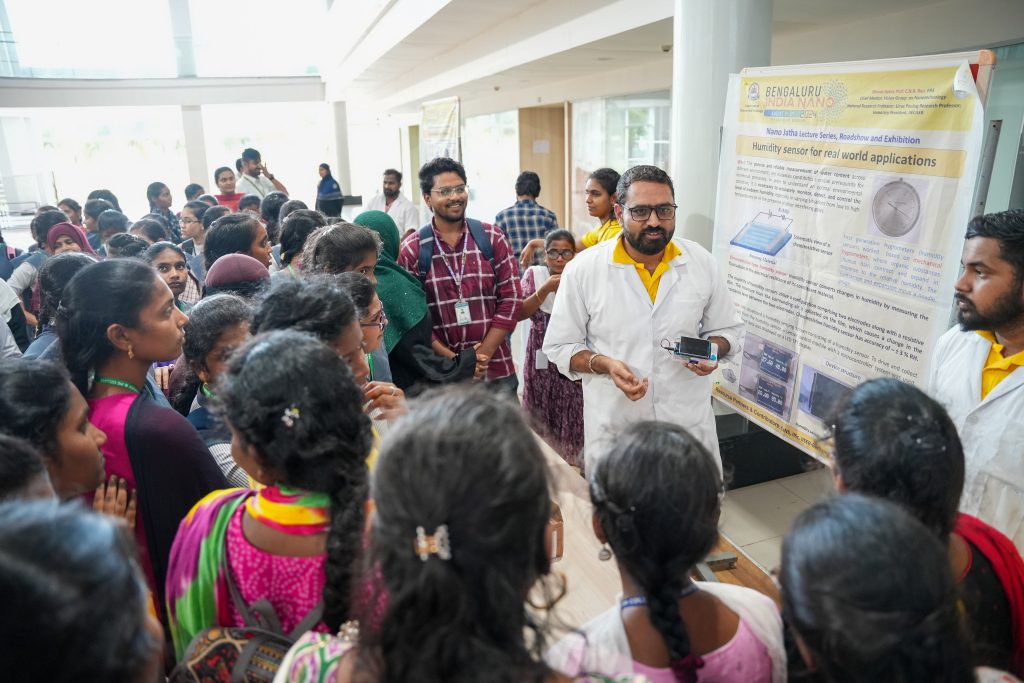
As part of the 13th edition of the Bengaluru India Nano 2024, heralded by Bharat Ratna recipient and renowned chemist Prof. C N R Rao, SRM University-AP hosted “Nano Jatha“, an intensive science outreach programme, catering to educate undergraduate graduates on the emerging trends of nanotechnology, on July 20, 2024. The Nano Jatha programme organised, aimed to raise awareness on nanoscience and technology through technical presentations by expert scientists and a distinctive live experiment demonstration of nano kits focused on showcasing nanoscience ideas.
The event featured two expert talks by eminent dignitaries. Prof. B L V Prasad, Director-Centre for Nano and Soft Matter Sciences (CeNS), Department of Science and Technology, Govt. of India, also serving as the Nodal Officer for organising Nano Jatha events, delivered a session on the introduction to nanoscience and technology. “Nanoscience and technology are often foretold as the technology of the future. This multidimensional technology will revolutionise our understanding of every natural phenomenon and every aspect of human life,” remarked Prof. Prasad in his session.
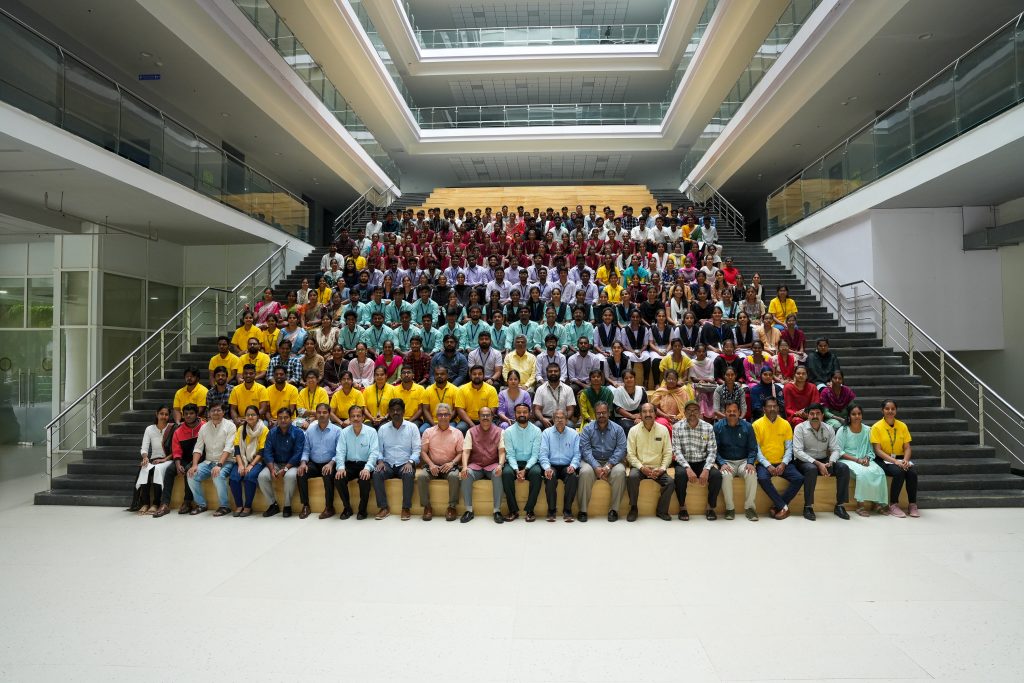
Prof. C P Rao, Senior Professor at the Department of Chemistry, presented the second expert talk on the applications of nanomaterials. The session delved into the properties of covalent molecules and its assemblage leading to cutting-edge technology. The programme also featured an exhibition were experiments on Gold nanoparticle; Galvanization reaction between metals; Piezoelectric pavement for futuristic applications; Humidity sensors for real-world applications and many more were displayed.
Prof. C V Tomy, Dean-School of Engineering & Sciences and Dr Pardha Saradhi Maram, Head-Department of Chemistry, emphasised that the Nano Jatha exemplified the university’s commitment to hands-on learning in science, specifically nanotechnology.They commented that the Department of Chemistry is dedicated to fostering scientific knowledge and igniting passion for chemistry among students and educators alike and will continue to organise events like Nano Jatha, conferences, workshops, and Faculty Development Programmes to achieve the same.
Over 300 students from 7 regional colleges in Andhra Pradesh participated in the programme, displaying their zeal in the discussions and nano kit demonstrations. The event was well executed benefitting the student community significantly in understanding various emerging fields in science and technology.
- Published in Chemistry-news, Departmental News, News
Faculty and Students Leads to Patent Publication for Intelligent Shelf Management System
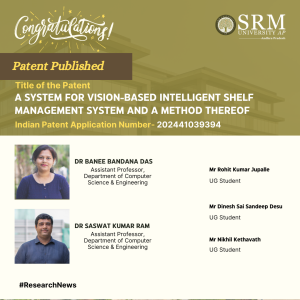 In a groundbreaking collaboration, Dr Banee Bandana Das, Assistant Professor in the Department of Computer Science and Engineering, and Dr Saswat Kumar Ram, Assistant Professor in the Department of Electronics and Communication Engineering, have joined forces with Btech-CSE students Mr Rohit Kumar Jupalle, Mr Dinesh Sai Sandeep Desu, and Mr Nikhil Kethavath to develop and patent an innovative invention.,” The team’s invention, titled “A SYSTEM FOR VISION-BASED INTELLIGENT SHELF MANAGEMENT SYSTEM AND A METHOD THEREOF,” has been officially filed and published with Application Number 202441039394 in the Patent Office Journal. This invention showcases the academic excellence and collaborative spirit within the institution, as faculty members and students work together to push the boundaries of technology and create solutions with real-world impact.
In a groundbreaking collaboration, Dr Banee Bandana Das, Assistant Professor in the Department of Computer Science and Engineering, and Dr Saswat Kumar Ram, Assistant Professor in the Department of Electronics and Communication Engineering, have joined forces with Btech-CSE students Mr Rohit Kumar Jupalle, Mr Dinesh Sai Sandeep Desu, and Mr Nikhil Kethavath to develop and patent an innovative invention.,” The team’s invention, titled “A SYSTEM FOR VISION-BASED INTELLIGENT SHELF MANAGEMENT SYSTEM AND A METHOD THEREOF,” has been officially filed and published with Application Number 202441039394 in the Patent Office Journal. This invention showcases the academic excellence and collaborative spirit within the institution, as faculty members and students work together to push the boundaries of technology and create solutions with real-world impact.
This significant achievement not only highlights the creativity and dedication of the individuals involved but also underscores the institution’s commitment to fostering a culture of innovation and research. The publication of this invention paves the way for further exploration and development in the field of intelligent shelf management systems, demonstrating the potential for transformative contributions to the industry.
Abstract
This research offers the best solution to improve the business in the retail realm, maintaining On- Shelf Availability (OSA) is vital for customer satisfaction and profitability. Traditional OSA methods face accuracy challenges, prompting a shift to deep learning models like YOLO and CNN. However, data quality remains a hurdle. This research introduces OSA, a novel semi-supervised approach merging ’semi-supervised learning’ and ’on-shelf availability’ with YOLO. It reduces human effort and computation time, focusing on efficient empty-shelf detection. Implementing a Vision-Based Intelligent Shelf Management System empowers retailers with real-time insights, revolutionizing decision-making. The model is optimized for diverse devices and provides practical solutions for efficient retail operations. Balancing model complexity, size, latency, and accuracy, the research paves the way for an advanced, data-driven shelf management approach, contributing to improved shopping experiences and business profitability
Practical Implementation and the Social Implications Associated
1. The present invention is a time-saving method in maintaining the stocks.
2. The use Vision-Based Intelligent Shelf-Management System provide a well alternative in reducing the labor efforts.
3. The system will help in terms of self-management system using machine learning techniques to optimize restocking decisions.
The present invention can be used in shopping malls and business areas for enhancing customer experiences and business and few application areas are:
• Smart City and smart Village
This technique and system can reduce the human efforts in identifying vacant slots for items in business areas and provides necessary inputs to fill the same within a time frame.
• Automobile Industry
The system can be easily integrated with the showrooms to identify the empty spaces and inform to get it fill with products.
Collaborations
SRM AP Faculties and UROP Students
Future research plan
In the future, different deep learning and machine learning methods can be merged to explore better performance in identifying overlapping objects.
- Published in CSE NEWS, Departmental News, ECE NEWS, News, Research News
Revolutionising Cattle Safety
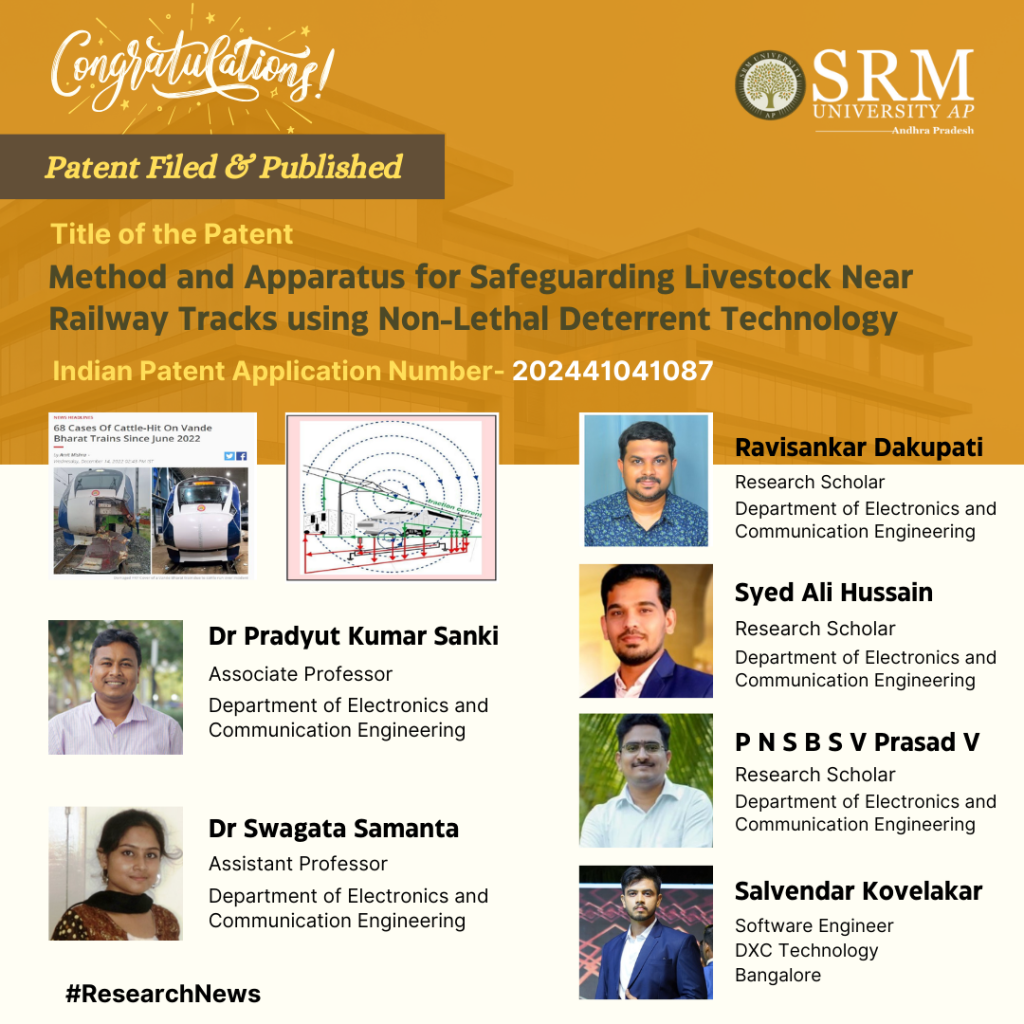
The Department of Electrical and Communication Engineering at SRM University-AP is delighted to announce the publication of a patent by its faculty, including Associate Professor Dr Pradyut Kumar Sanki and Assistant Professor Dr Swagata Samanta, along with research scholars Ravisankar Dakupati, Syed Ali Hussain, and P N S B S V Prasad V. The patent, titled “Method and Apparatus for Safeguarding Livestock Near Railway Tracks using Non-Lethal Deterrent Technology,” has introduced a groundbreaking solution that helps prevent accidents of wandering cattle. This innovative technology promises to protect livestock and minimise economic losses for cattle owners while championing the advancement of technology in countries like India.
Abstract:
Nowadays we have been hearing that Vandebharat express train hits cow, causing damage to both railways and cattle owners. We need to find a solution to this problem. These issues shouldn’t be hurdle for the growth of technology for developing countries like india. The technology we are going to use is a belt is worn by a cow. When the cow tries to cross near railway track it receives a Non-Lethal shock, makes the cow to scare and move back. All this circuit is operated with 7.4V DC
Practical implementation:
The practical implementation of the Anti-Track Cattle Band involves equipping cows with the device to prevent accidents near railway tracks. By detecting magnetic fields and delivering non-lethal shocks, the device ensures the safety of both the cattle and the railway infrastructure. This implementation can significantly reduce the risk of collisions and protect valuable livestock.
From a social perspective, the invention has several implications. It addresses the safety concerns of both animals and humans by preventing accidents and minimizing potential harm. By safeguarding livestock near railway tracks, the technology contributes to animal welfare and reduces economic losses for cattle owners. Additionally, the device promotes a more humane and proactive approach to mitigating risks associated with animal-human interactions in railway environments.
Collaborations:
The research on the Anti-Track Cattle Band involved collaboration among a team of inventors with diverse expertise:
Ravisankar Dakupati – Research Scholar at SRM University-AP
Salvendar Kovelakar – Software Engineer at DXC Technology, Bangalore
Syed Ali Hussain – Research Scholar at SRM University-AP
P N S B S V Prasad V – Research Scholar at SRM University-AP
Dr Pradyut Kumar Sanki – Associate Professor at SRM University-AP
Dr Swagata Samanta – Assistant Professor at SRM University-AP
This collaborative effort brought together individuals with backgrounds in research, software engineering, and academia to develop and implement the innovative Anti-Track Cattle Band technology.
Future Research Plans:
In future research for patent publication regarding “Apparatus and Method for Railway Livestock Protection,” the focus will likely be on enhancing sensor technology to detect animals more accurately over longer distances and in various conditions. This could involve integrating artificial intelligence and machine learning for improved detection and reducing false alarms. Additionally, there may be efforts to develop systems for remote monitoring and control, enabling real-time adjustments from a central location. Adaptability to different environments, collaboration for standardized protocols, cost-effectiveness, and assessing environmental impacts will also be key areas of interest. Overall, future research aims to create more effective, efficient, and sustainable solutions for protecting livestock around railway tracks
- Published in Departmental News, ECE NEWS, News, Research News
A Breakthrough Patent for the Automated Abnormality Detection System
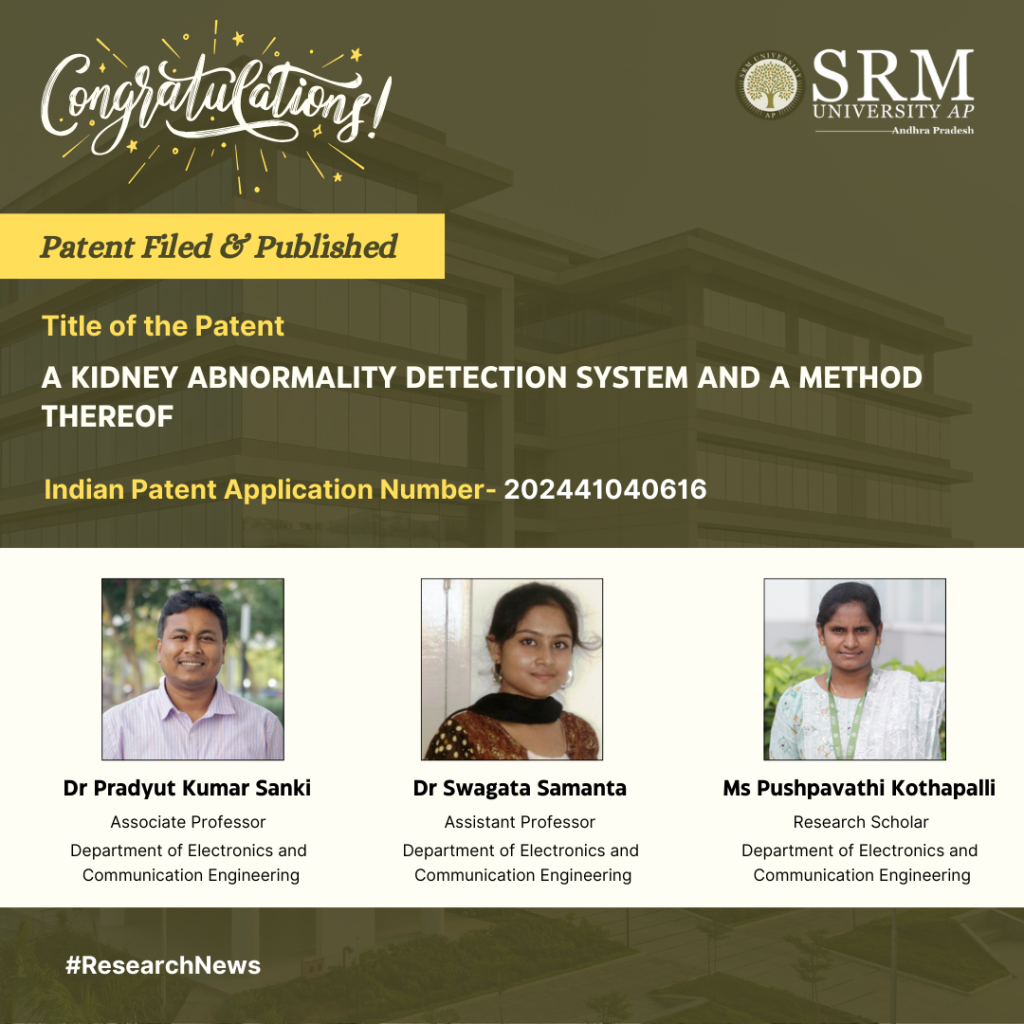
Dr Pradyut Kumar Sanki, Dr Swagata Samanta, and research scholar Ms Pushpavathi Kothapalli from the Department of Electronics and Communication Engineering published their patent titled “A Kidney Abnormality Detection System And a Method Thereof,” with Application No. 202441040616. This innovative method, which utilises advanced deep learning techniques, promises to revolutionise the accuracy and efficiency of kidney disease diagnosis. With the potential for widespread clinical adoption, this technology aims to enhance patient care, offering a brighter future for kidney disease detection and treatment.
Abstract:
This research work aimed to develop a method for detecting kidney diseases, including kidney stones, cysts, and tumors. The method achieved high accuracy in detecting kidney diseases, with a good mean average precision, precision, and recall. The study used techniques to select the most relevant features for kidney disease detection, identifying top features related to blood tests and patient health. The method outperformed other approaches in terms of accuracy, precision, and recall. The study used a comprehensive dataset of kidney disease patients to train and test the method. The results suggest that the method has the potential to be widely adopted in clinical settings, contributing to more accurate and efficient diagnostic tools for kidney disease detection and improving patient care.
Practical implementation:
The practical implementation of our research involves deploying a system for real-time detection and classification of kidney disease, including kidney stones, cysts, and tumors. The method achieved high accuracy in detecting kidney diseases using the Deep learning technique. Our model can quickly identify the disease of the kidney. The study used techniques to select the most relevant features for kidney disease detection, identifying top features related to blood tests and patient health. The method outperformed other approaches in terms of accuracy, precision, and recall. The study used a comprehensive dataset of kidney disease patients to train and test the method. The results suggest that the method has the potential to be widely adopted in clinical settings, contributing to more accurate and efficient diagnostic tools for kidney disease detection and improving patient care.
Future Research Plans:
The future plans for the work on chronic kidney disease (CKD) detection and management involve several key areas:
1. Improved Screening and Diagnosis: Update the United States Preventive Services Task Force (USPSTF) recommendation for CKD screening to reflect current evidence supporting routine screening for high-risk asymptomatic adults.
2. Enhanced Patient Engagement and Person-Centered Care: Advance education of primary care clinicians about CKD risk factors, testing, detection, and interventions that are graded and proportional to the eGFR and uACR risk stratification or heat map.
3. Advancements in Nephrology: Develop novel therapeutic strategies, such as wearable artificial kidneys, xenotransplantation, stem cell-derived therapies, and bioengineered and bio-artificial kidneys, to improve renal replacement therapies and address the shortage of kidney donors.
4. Machine Learning and Predictive Modelling: Continue to evaluate and improve machine learning approaches for early CKD diagnoses, focusing on reducing the number of input features and enhancing the accuracy of prediction models.
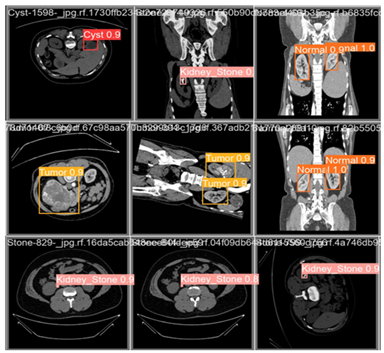
- Published in Departmental News, ECE NEWS, News, Research News
Dr Basu Pens a Book on Life’s Boulevard
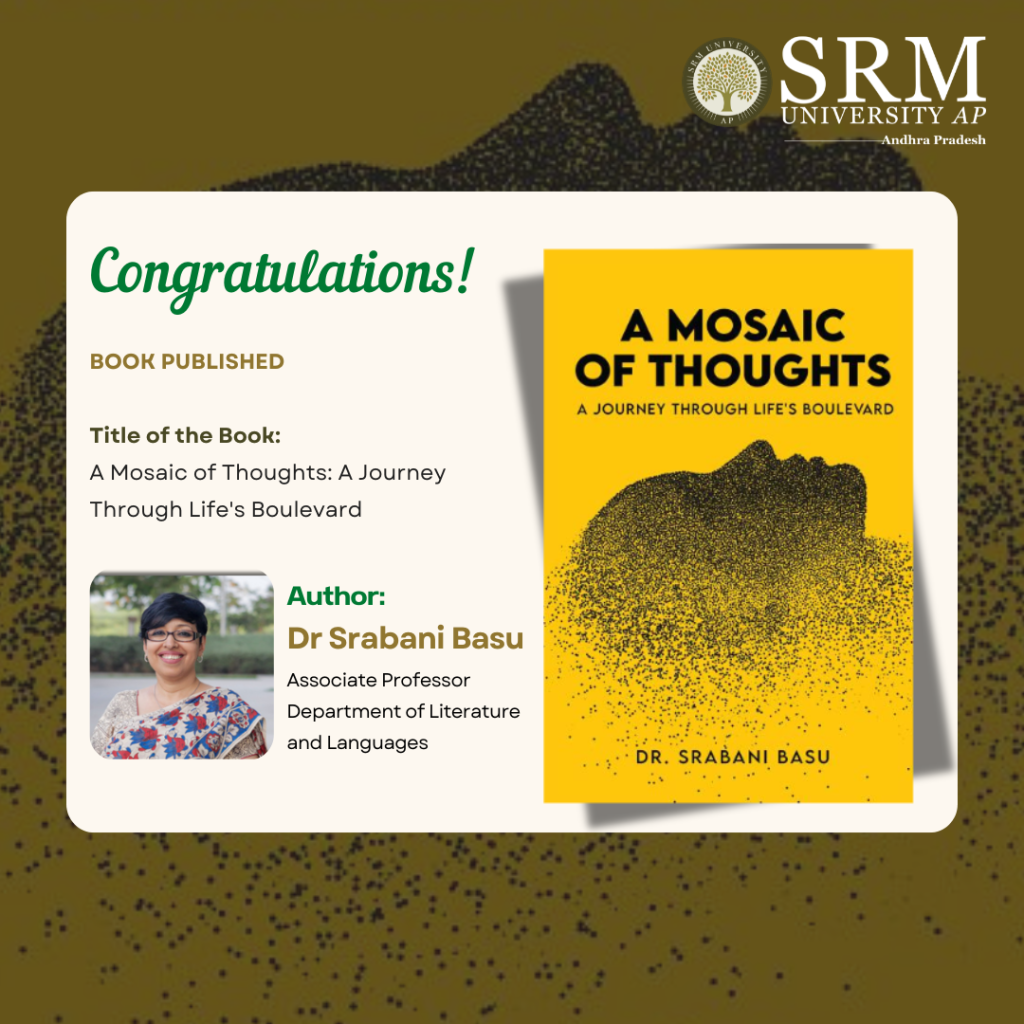 In the esteemed corridors of academia, where the pursuit of knowledge intertwines with the art of mentorship, Dr Srabani Basu emerges as a figure of inspiration and innovation. Nestled within the vibrant community of SRM University-AP. Dr Basu is not just an Associate Professor in the Department of Literature and Languages, but a beacon of intellectual and administrative prowess. Her recent publication, A Mosaic of Thoughts: A Journey Through Life’s Boulevard, is a book of 12 insightful articles that recount interesting snippets of life and experiences both in Academia and Corporate.
In the esteemed corridors of academia, where the pursuit of knowledge intertwines with the art of mentorship, Dr Srabani Basu emerges as a figure of inspiration and innovation. Nestled within the vibrant community of SRM University-AP. Dr Basu is not just an Associate Professor in the Department of Literature and Languages, but a beacon of intellectual and administrative prowess. Her recent publication, A Mosaic of Thoughts: A Journey Through Life’s Boulevard, is a book of 12 insightful articles that recount interesting snippets of life and experiences both in Academia and Corporate.
Abstract:
Dive into “Mosaic of Thought,” a captivating collection of 12 insightful articles exploring the intricacies of contemporary life. This book challenges conventional thinking with themes such as “Are We Manufacturing Countless Bricks in the Wall?” questioning conformity in education and society, and “Of Apes, Leaders, and Organisations,” delving into the primal roots of leadership. Navigate learning complexities in “Is Your Map Meeting Your Learner’s Map?” and confront harassment in “Bullies of All Colours.” Discover the culture of blame in “Blame is the Name of the Game,” and re-imagine cartoons with “Re-discovering Tom and Jerry Through a Quantum Lens.” Each article offers unique perspectives, from fleeting moments in “The Irreplaceable Moments Explored” to impactful first impressions in “Of Halos and Horns.” With humour and seriousness, “A Comedy of Ctrl C and Ctrl V” critiques digital originality, while “Echoes of Influence: A Caveat” warns of the impact of words. This collection is a thought-provoking mosaic for understanding the multifaceted canvas of life.
About the Author:
Dr Srabani Basu, with a distinguished career spanning over 29 years, is an accomplished academic and corporate trainer. Currently serving as an Associate Professor in the Department of Literature & Languages at SRM University, A.P., she has an extensive background in education and training. Dr Basu earned her PhD in English from IKSVV (India’s first Music & Fine Arts University) in Chhattisgarh, India, in 2003. She also holds a PGDBM in Public Relations from Bhavan’s College of Communication & Management, Kolkata, and an MS in Psychoanalysis from IPMS, Mumbai, with a specialization in Students’ Psychology.
Dr Basu has held significant roles as a senior corporate trainer, master coach, content developer, and organisation development specialist. Her experience includes training across diverse industries such as media, banking, telecom, IT, ITES, engineering, FMCG, manufacturing, and education. Her expertise lies in delivering life – skills solutions and providing qualitative improvements. With a profound understanding of human psychology, Dr Basu excels in creating engaging and effective training and classroom sessions that empower participants and students in fostering individual creativity.
In addition to her academic and training roles, Dr Basu is a certified Career Transition Coach, a Neuro-Linguistic Programming (NLP) Master Practitioner, and a Gestalt Master Practitioner. She adeptly customizes her content to match the experience level and knowledge of her target audience and often integrates insights from multiple disciplines to provide holistic learning for the learners. She strongly believes that “Our ambition should be to rule ourselves, the true kingdom for each one of us; and true progress is to know more, and be more, and to do more.”
We wish her all the best for her book and hope for many more to come.
For more details:
https://notionpress.com/read/a-mosaic-of-thoughts?book=published&utm_source=share_publish_email&utm_medium=email
- Published in Departmental News, English news, News, Research News
Dr Soni Wadhwa Publishes Paper on Digital Libraries for Minor Languages in India
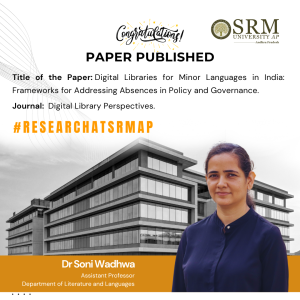 In a significant academic achievement, Dr Soni Wadhwa, Assistant Professor in the Department of Literature and Languages, has recently published a paper titled “Digital Libraries for Minor Languages in India: Frameworks for Addressing Absences in Policy and Governance.” The paper was published in the esteemed Journal Digital Library Perspectives. Dr Wadhwa’s research illuminates the importance of establishing digital libraries for minor languages in India and proposes frameworks to address existing gaps in policy and governance. This pioneering work not only explores the significance of preserving linguistic diversity but also advocates for inclusive and accessible digital resources for all.
In a significant academic achievement, Dr Soni Wadhwa, Assistant Professor in the Department of Literature and Languages, has recently published a paper titled “Digital Libraries for Minor Languages in India: Frameworks for Addressing Absences in Policy and Governance.” The paper was published in the esteemed Journal Digital Library Perspectives. Dr Wadhwa’s research illuminates the importance of establishing digital libraries for minor languages in India and proposes frameworks to address existing gaps in policy and governance. This pioneering work not only explores the significance of preserving linguistic diversity but also advocates for inclusive and accessible digital resources for all.
The publication of this paper not only adds to Dr Wadhwa’s scholarly contributions but also highlights the commitment of SRM University-AP faculty members to engaging in research that can have a positive impact on society.
Abstract
This study aims to deliberate on strategies for enlisting community support for gathering diverse learning resources in different languages and for enlisting participation in activities such as crowdsourcing in initiatives such as annotations and transliteration. This paper calls for interventions that imagine and create infrastructure for the flourishing of smaller libraries that can draw from and feed into large-scale national and international libraries. Offering a conceptual framework to rethink the country’s approach toward minor languages, it first offers an overview of policies and initiatives relevant to the concerns of minor languages in digital libraries in India. Based on the policy analysis, it then goes on to suggest starting points for policy designers and custodians of libraries to help them work toward better representation of languages in their resources.
The existing frameworks analyzed here for the greater or representation of minor Indian languages reveal a culture of silence toward the issue of language. With some advocacy, these frameworks can be mined to craft different ways that are critical not just for enriching libraries but also for preservation of cultural heritage of the communities concerned, thus adding a larger social dimension to the question of access.
Explanation of the Research in Layperson’s terms
Given that Indian languages in general are under-represented on the internet and that languages of minority linguistic groups find very little space on digital platforms, it is imperative for institutions such as libraries to cater to smaller communities and their educational needs while also reaching out to them in their own languages. While a lot of socio-political discourse on minority languages in India exists, this study pushes for their bearing on digital libraries, educational frameworks and cultural heritage. It offers five suggestions for strengthening the presence of minor languages in digital libraries in India.
Details in citation format
Wadhwa, S. (2024), “Digital libraries for minor languages in India: frameworks for addressing absences in policy and governance”, Digital Library Perspectives, Vol. ahead-of-print No. ahead-of-print. https://doi.org/10.1108/DLP-01-2024-0002
Practical Implications
This viewpoint paper can be used to enhance policy and governance around libraries. With National Education Policy 2020, which emphasises the importance of learning in regional/mother/Indian languages, Indian educational system as well as social institutions need stronger platforms to make resources in Indian languages available to students as well as lifelong learners. With more of such research, it will be possible to come up better digital infrastructure for Indian languages.
Social Implications
Indian languages are not widely represented on the Internet and in the knowledge set up. Making existing resources and knowledge available in digital libraries will stimulate further research on generating further research and knowledge production in Indian languages. It is hoped that more research in the domain of Indian languages works towards the digital divide and knowledge divide in India.
Collaborations
This research came out of the researcher’s previous archival work. Her digital archive PG Sindhi Library is dedicated to post-partition Sindhi writing in India. This article is based on an invited talk delivered at the international symposium titled “Digital Libraries: Sustainable Development in Education” held at IIT Kharagpur in India in November 2023. The author is grateful to the organisers and fellow participants for their feedback.
Future Research Plans
The researcher is involved in a sanctioned project titled “Sindhi Sanchaya: Building a Comprehensive and Interactive Database of a Partitioned Literature” funded by IIT Indore. She hopes to build on this work produced in this article as she makes progress in the project.
- Published in Departmental News, English Current Happenings, News, Research News


